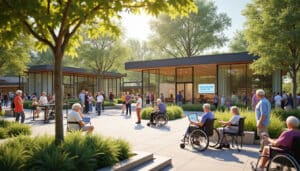The long-term care units (USLD) represent essential structures within the French health system. Designed to accommodate and care for dependent elderly individuals or patients with specific health needs, these establishments offer medical care and continuous support tailored to the requirements of each resident. By assessing these structures, it becomes possible to better understand their operation, services, and the importance they hold in the medical landscape.
The long-term care units (USLD) are specialized facilities for accommodating dependent elderly individuals or patients suffering from chronic diseases requiring constant medical follow-up. These medicalized structures aim to provide care tailored to the specific needs of each resident, thereby ensuring their safety and well-being on a daily basis.
The operation of USLDs relies on an interdisciplinary approach, where various health professionals collaborate to provide comprehensive care. These establishments are generally integrated into hospital structures or clinics, which allows for access to high-performance equipment and highly qualified medical staff. USLDs are distinguished from residential facilities for dependent elderly individuals (EHPAD) by their predominantly medical orientation and the nature of the care provided.
Admissions to USLDs are often reserved for individuals over 60 years old or younger patients with severe pathologies. To access these units, an assessment process is necessary, based on the AGGIR dependency scale (Autonomy Gerontology Groups Iso-Resources). This system allows for the evaluation of the level of dependence and determination of whether the person requires long-term care.
USLDs accommodate residents suffering from a variety of pathologies, such as Alzheimer’s disease, Parkinson’s disease, the aftereffects of strokes (AVC), as well as other medical disorders requiring close monitoring. The care provided is ensured by geriatricians, nurses, and nursing assistants, thereby guaranteeing high-quality medical service.
Another fundamental aspect of USLDs is the provision of rehabilitation and re-adaptation services that contribute to improving residents’ autonomy. Physiotherapy sessions, occupational therapy, and other forms of therapy are often offered to maintain an optimal level of physical and cognitive activity.
The living environment in USLDs is designed to be secure and comfortable. Although less personalized than in EHPADs, each resident benefits from accommodation suited to their needs, as well as individualized support. The daily routine includes communal meals, scheduled medical care, and social activities aimed at stimulating the residents and fostering their social engagement.
However, it is essential to consider the challenges faced by USLDs. The growing demand for long-term care, due to the aging population, puts pressure on available resources. Moreover, maintaining an adequate level of care quality while managing budget constraints is an ongoing challenge.
In terms of funding, admissions to USLDs are generally covered by Health Insurance, while residents may benefit from the Personalized Autonomy Allowance (APA) or Social Accommodation Aid (ASH) depending on their resources. These aids help reduce the cost of care and ensure residents have access to adequate services.
In conclusion, long-term care units play a crucial role in the health system. They offer tailored solutions for dependent elderly individuals, ensuring that each resident receives the necessary care while preserving their dignity and quality of life. These establishments are inseparable from support in the field of geriatric care and medico-social services, committed to addressing the challenges of aging with compassion and expertise.

FAQ: Definition of USLD
What is an USLD? A Long-Term Care Unit (USLD) is a medicalized structure that accommodates dependent elderly persons or patients of any age requiring constant medical care.
Who are USLDs for? USLDs are primarily aimed at seniors over 60 years old but may also accommodate younger patients suffering from chronic or severe illnesses.
What are the differences between an USLD and an EHPAD? USLDs are distinguished from Residential Facilities for Dependent Elderly Persons (EHPAD) by their more medical orientation and the continuous medical care they provide.
What types of care are offered by USLDs? USLDs offer medical care, rehabilitation, psychological support, as well as social and leisure activities tailored to the needs of residents.
How does admission to an USLD take place? Admission is generally done on medical prescription, and the patient must meet specific criteria, such as being over 60 years old or showing significant loss of autonomy.
How are USLDs funded? USLDs are funded by the public and private sectors, with costs covered by the state, departments, mutuals, and insurances, as well as a contribution from residents based on their income.
What is the cost of an USLD? The cost of accommodation in an USLD can vary from 50 to 100 euros per day, depending on the establishment and the services offered.
What financial aids are available for USLD residents? Residents can benefit from the Personalized Autonomy Allowance (APA) and Social Accommodation Aid (ASH) if their resources are insufficient.
What challenges do USLDs face? USLDs must face challenges such as the aging population, limited resources, and the need to maintain a high level of care despite budget constraints.











